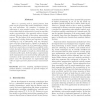Free Online Productivity Tools
i2Speak
i2Symbol
i2OCR
iTex2Img
iWeb2Print
iWeb2Shot
i2Type
iPdf2Split
iPdf2Merge
i2Bopomofo
i2Arabic
i2Style
i2Image
i2PDF
iLatex2Rtf
Sci2ools
SMI
2006
IEEE
2006
IEEE
Segmenting Point Sets
There is a growing need to extract features from point sets for purposes like model classification, matching, and exploration. We introduce a technique for segmenting a point-sampled surface into distinct features without explicit construction of a mesh or any other surface representation. Our approach achieves computational efficiency through a three-phase segmentation process. The first phase of the process adapts a topological approach to define features and coarsens the input, resulting in a set of supernodes, each one representing a collection of input points. A graph cut is applied in the second phase to bisect the set of supernodes. Similarity between supernodes is computed as a weighted combination of geodesic distances and connectivity. Repeated application of the graph cut results in a hierarchical segmentation of the input. In the last phase, a segmentation of the original point set is constructed by refining the segmentation of the supernodes based on their associated ...
| Added | 12 Jun 2010 |
| Updated | 12 Jun 2010 |
| Type | Conference |
| Year | 2006 |
| Where | SMI |
| Authors | Ichitaro Yamazaki, Vijay Natarajan, Zhaojun Bai, Bernd Hamann |
Comments (0)

